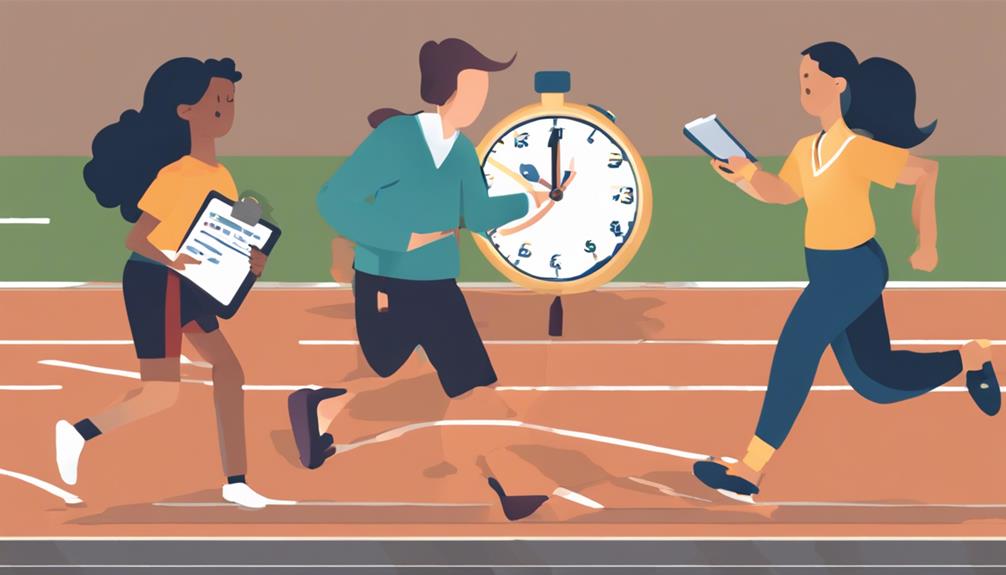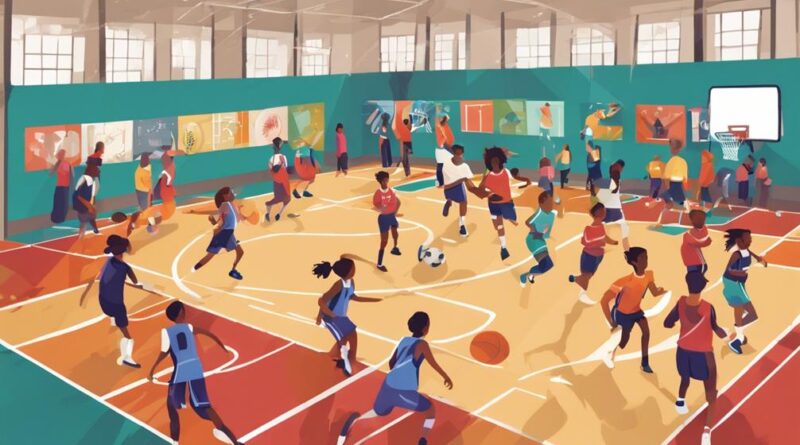Incorporating Athletics Into School PE Curriculum: How-To
Tired of the same old PE routines? Perhaps it's time to spice things up by incorporating athletics into your school's curriculum.
Discover how to seamlessly blend traditional physical education practices with dynamic athletic activities that will not only engage your students but also enhance their overall fitness levels.
By following a few key steps, you can revolutionize your PE classes and leave a lasting impact on your students' physical development.
Benefits of Including Athletics
By incorporating athletics into the school PE curriculum, students can develop essential physical skills and improve overall health. Engaging in athletic activities such as running, jumping, and throwing can significantly contribute to improved fitness levels among students. Regular participation in sports like basketball, soccer, or track and field can help enhance cardiovascular endurance, strength, flexibility, and coordination. These physical benefits not only promote a healthier lifestyle but also increase overall energy levels and productivity throughout the day.
Furthermore, participating in athletics fosters team building skills among students. Being part of a sports team teaches individuals the importance of communication, cooperation, and collaboration. Through working together towards a common goal, students learn how to support and rely on one another, building trust and camaraderie. Team sports also provide opportunities for students to develop leadership skills, learn how to handle both victories and defeats gracefully, and understand the value of perseverance and hard work.
Selecting Suitable Athletics Activities
When considering suitable athletics activities for the school PE curriculum, prioritize options that cater to diverse interests and skill levels among students. It's crucial to focus on activities that promote skill development and are age-appropriate to ensure that all students can participate and progress. Incorporating a variety of activities such as running, jumping, throwing, and team sports can help students enhance their physical abilities while having fun.
To foster an inclusive environment, choose activities that allow all students to feel valued and participate regardless of their skill level. This inclusivity not only promotes a sense of belonging but also encourages team building among students. Team sports like basketball, soccer, or relay races can help students learn to work together, communicate effectively, and support one another towards a common goal.
When selecting athletics activities, consider the equipment needed and the space available. Opt for activities that require minimal equipment to make implementation easier and more cost-effective. Additionally, ensure that the space allows for safe and enjoyable participation in the chosen activities.
Integrating Athletics With Curriculum
To enhance student engagement and holistic development, consider integrating athletics seamlessly with the school curriculum. By incorporating athletics into the curriculum, students have the opportunity to not only improve their physical health but also develop essential skills and foster teamwork.
Skill development is a crucial aspect of integrating athletics with the curriculum. Through participating in sports activities during PE classes, students can enhance a wide range of skills such as coordination, agility, strength, and endurance. These skills aren't only important for physical health but can also translate into other areas of their academic and personal lives. For example, improved coordination can help students excel in subjects that require fine motor skills, while increased endurance can help them stay focused for longer periods during study sessions.
Moreover, integrating athletics with the curriculum promotes team building among students. Sports activities often require collaboration, communication, and trust among team members to achieve a common goal. By working together towards success in athletic endeavors, students learn the value of teamwork, develop leadership skills, and build strong relationships with their peers. These interpersonal skills are essential for success in school, the workplace, and beyond.
Designing Engaging Athletics Sessions
Consider structuring your athletics sessions to be both engaging and purposeful, ensuring students actively participate and benefit from the integrated curriculum. Here are some key points to keep in mind when designing your sessions:
- Skill Development: Plan activities that focus on specific skills relevant to the sport or activity you're teaching. Break down complex skills into smaller components to help students grasp them more easily.
- Motivation Techniques: Keep students motivated by incorporating fun challenges, setting achievable goals, and providing positive reinforcement. Encourage friendly competition to push students to improve.
- Team Building: Include activities that require students to work together towards a common goal. Team sports or partner drills can foster cooperation and communication among students.
- Goal Setting: Help students set personal goals related to their athletic performance. Encourage them to track their progress and celebrate their achievements, no matter how small. This can boost their confidence and keep them engaged in the sessions.
Importance of Proper Equipment
Proper equipment plays a crucial role in ensuring the safety and effectiveness of athletic activities. When it comes to incorporating athletics into the school PE curriculum, prioritizing equipment maintenance and adherence to safety standards is paramount. Regular maintenance checks on items like balls, mats, or protective gear can help prevent accidents or injuries during physical education classes. Ensuring that equipment meets safety standards set by relevant authorities or sports organizations is essential to safeguarding students during sports activities.
Moreover, budget considerations play a significant role in equipment procurement for school PE programs. Schools often have limitations on their budgets, making it important to prioritize purchases that are both safe and essential for athletic sessions.
When acquiring equipment, it's crucial to balance cost-effectiveness with quality to provide students with the best tools for their physical development. Proper research and planning can help schools make informed decisions about which equipment to invest in, ensuring that students have access to the necessary gear for a well-rounded athletics curriculum.
Ensuring Safety Measures
Safety should always be the top priority when implementing athletics into the school PE curriculum. To ensure a safe environment for students to engage in physical activities, it's crucial to follow specific safety guidelines and focus on injury prevention. Here are four essential measures to guarantee the well-being of all participants:
- Proper Warm-Up: Begin each session with a dynamic warm-up routine to prepare the muscles and reduce the risk of injuries during physical activities. Incorporate activities like jogging, stretching, and light exercises to gradually increase heart rate and flexibility.
- Supervision: Assign qualified coaches or teachers to supervise the students actively engaging in athletic activities. Adequate supervision helps in identifying and addressing any safety concerns promptly, ensuring a safe and controlled environment.
- Use of Safety Equipment: Emphasize the importance of using appropriate safety equipment during athletic sessions. Ensure that students wear helmets, pads, or any other necessary gear based on the specific sport or activity to minimize the risk of injuries.
- Hydration and Rest Breaks: Encourage students to stay hydrated throughout the session by providing access to water and scheduled breaks. Proper hydration and rest intervals are essential for maintaining energy levels and preventing fatigue-related injuries.
Evaluating Student Performance

When assessing student performance in athletics, focus on individual progress and skill development to gauge their improvement effectively. Performance assessment in physical education classes should aim to provide constructive feedback while encouraging students to set goals for themselves. By emphasizing skill development, educators can tailor their evaluations to focus on the specific abilities and techniques each student is working to improve.
To effectively evaluate student performance, consider implementing a variety of assessment methods. These could include skill-based assessments where students demonstrate their proficiency in specific athletic techniques, such as shooting a basketball or performing a gymnastics routine. Additionally, incorporating peer evaluations or self-assessments can offer different perspectives on individual progress and encourage students to reflect on their own development.
It's essential to provide students with clear criteria for evaluation, outlining the specific skills or competencies they're expected to demonstrate. By setting concrete expectations, students can better understand how their performance is being assessed and what areas they need to focus on for improvement. Offering regular feedback and opportunities for students to track their progress can further enhance the effectiveness of performance evaluations in the physical education setting.
Seeking Continuous Improvement
To enhance your athletic performance in school, consistently strive for progress and growth through dedicated practice and feedback. Continuous assessment and progress tracking are essential components in your journey towards improvement. Here are some practical steps to help you achieve continuous improvement:
- Set Clear Goals: Define specific and measurable goals for yourself in each athletic endeavor. Whether it's improving your running speed or enhancing your basketball shooting accuracy, having clear targets will guide your practice sessions.
- Regularly Reflect on Your Performance: Take time to reflect on your practices and competitions. Analyze what went well and areas that need improvement. This self-assessment will provide valuable insights into your progress.
- Seek Feedback from Coaches and Peers: Don't hesitate to ask for feedback from your coaches and teammates. Constructive criticism can help you identify blind spots and areas where you can refine your skills.
- Adjust and Adapt: Use the feedback you receive to make adjustments to your training routines. Be flexible in trying new techniques or approaches to see what works best for you.
Frequently Asked Questions
How Can Schools Address Budget Constraints When Incorporating Athletics Into the PE Curriculum?
When adding athletics to the PE curriculum with budget constraints, it is essential to carefully manage funds and prioritize essential athletic equipment.
Look for cost-effective options, such as purchasing used gear or seeking sponsorships from local businesses. By being resourceful and creative with your budget, you can still provide students with a quality athletic experience.
Are There Resources Available for Teachers to Receive Additional Training in Specific Athletics Activities?
Looking for training resources and certification programs for specific athletics activities? There are various options available to teachers seeking additional expertise in this area.
Many organizations offer workshops, online courses, and certifications tailored to enhance your skills in teaching athletics. These resources can provide you with the necessary knowledge and tools to effectively incorporate different sports into your PE curriculum.
Explore these opportunities to further develop your teaching abilities in athletics.
How Can Schools Ensure Inclusivity and Accommodate Students With Varying Abilities in Athletics Sessions?
To ensure inclusivity and accommodate students with varying abilities in athletics sessions, schools can implement adaptive modifications and inclusive practices.
By offering modified activities, providing individualized support, and fostering a welcoming environment, all students can participate and benefit from physical education.
Encouraging teamwork, emphasizing effort over performance, and celebrating progress can create a supportive atmosphere where every student feels included and valued in athletics sessions.
What Strategies Can Be Implemented to Encourage Participation and Enthusiasm for Athletics Among Students?
To boost student engagement in athletics, provide varied options that cater to different interests and abilities. Offer motivational incentives like rewards for participation or friendly competitions.
Encourage teamwork and camaraderie to enhance enthusiasm. By creating a positive and inclusive environment, students are more likely to actively participate and enjoy athletics.
These strategies can foster a love for sports and physical activity among all students, promoting a healthier school community.
How Can Schools Involve Parents and the Community in Supporting the Athletics Program Within the PE Curriculum?
To involve parents and the community in supporting the athletics program within the PE curriculum, you can host parent information sessions, organize community sports events, and seek sponsorships from local businesses. By fostering community involvement, you can increase support for the program.
Engaging parents through volunteer opportunities and fundraising initiatives can help address funding challenges and provide budget solutions for the athletics program.
Conclusion
Incorporating athletics into your school PE curriculum can provide numerous benefits for students. These benefits include improved physical health, teamwork skills, and overall academic performance.
By selecting suitable activities, integrating them with curriculum objectives, and designing engaging sessions, you can create a fun and educational experience for your students.
Remember to prioritize safety and proper equipment, evaluate student performance, and seek continuous improvement to ensure a successful athletic program in your school.
